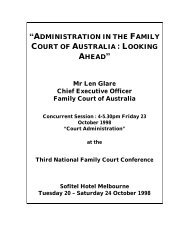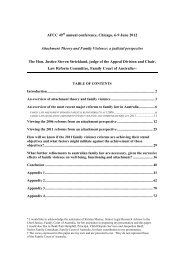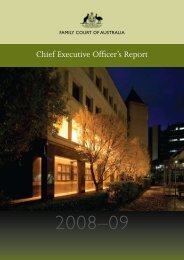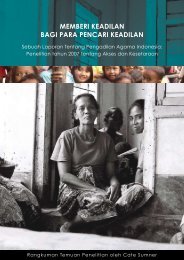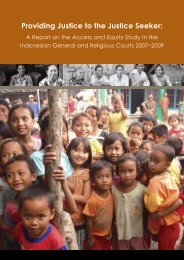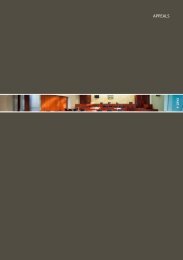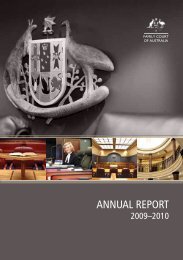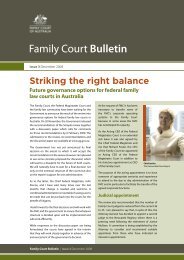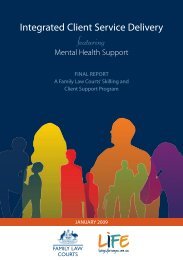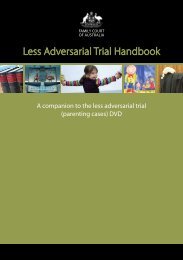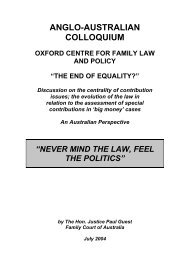Annual report [1997-98] - Family Court of Australia
Annual report [1997-98] - Family Court of Australia
Annual report [1997-98] - Family Court of Australia
Create successful ePaper yourself
Turn your PDF publications into a flip-book with our unique Google optimized e-Paper software.
The <strong>Family</strong> <strong>Court</strong> <strong>of</strong> <strong>Australia</strong> – annual <strong>report</strong> <strong>1997</strong>-<strong>98</strong><br />
Workplace diversity and equal employment opportunity<br />
The <strong>Court</strong> has implemented the 1995-<strong>98</strong> Equal Employment Opportunity (EEO) Plan and<br />
will be maintaining the work done in this area through its inclusion <strong>of</strong> Equal Employment<br />
Opportunity principles in the Diversity Strategy that was recently completed.<br />
Implementation <strong>of</strong> the strategy will proceed in the next financial year.<br />
Amajor achievement during the life <strong>of</strong> this Plan is the <strong>Court</strong> winning the open category <strong>of</strong><br />
the <strong>1997</strong> Equity Awards (sponsored by the Public Service and Merit Protection<br />
Commission and the Institute <strong>of</strong> Public Administration in <strong>Australia</strong>) for its success with the<br />
Aboriginal and Torres Strait Islander <strong>Family</strong> Consultant project. This project has resulted<br />
in a number <strong>of</strong> significant initiatives, among them the selection <strong>of</strong> five Aboriginal staff<br />
members and one Torres Strait Islander staff member to provide <strong>Court</strong> counselling consultancy<br />
services to their local communities in the Northern Territory and Queensland (see<br />
also Year in Review – Aboriginal and Torres Strait Islander issues).<br />
Other significant achievements are the completion <strong>of</strong> the <strong>Court</strong>’s Disability Action Plan and<br />
implementation <strong>of</strong> a detailed workplace harassment policy. The Action Plan was completed<br />
by a working group set up to develop a strategy incorporating EEO requirements and the<br />
directions included in the Commonwealth Disability Strategy. The group is part <strong>of</strong> the EEO<br />
sub-committee to the National Consultative Committee and was joined by staff with disabilities<br />
and/or staff interested in assisting staff with disabilities.<br />
As previously <strong>report</strong>ed, implementation <strong>of</strong> the 1995-<strong>98</strong> EEO Plan has resulted in the<br />
<strong>Australia</strong>n National Audit Office recognising the <strong>Court</strong>’s employment <strong>of</strong> women, especially<br />
in senior management, as best practice. EEO statistics for women at the SES level show the<br />
<strong>Court</strong> is outperforming most other agencies and is ahead <strong>of</strong> year 2000 targets.<br />
Resources<br />
Throughout <strong>1997</strong>-<strong>98</strong> the senior executive responsible for EEO was the Chief Finance<br />
Officer (formerly Principal Director Administration) – this position is Senior Executive<br />
(Generalist) Band 1 located in the Office <strong>of</strong> the Chief Executive in Sydney. The EEO coordinator<br />
was the Assistant Director <strong>of</strong> Policy Practices and Procedures (Senior Officer<br />
Grade C). There were two managers in the Sydney-based Policy, Practices and Procedures<br />
Unit with the responsibility <strong>of</strong> being EEO contact <strong>of</strong>ficers to assist <strong>Court</strong> staff.<br />
Harassment contact <strong>of</strong>ficers are located in each registry and appointments are made only<br />
after the nominated staff member has attended appropriate training such as a Public Service<br />
Commission program. They <strong>report</strong> quarterly to the EEO coordinator.<br />
Due to a restructuring, EEO responsibilities will pass to new positions next year.<br />
Consultative mechanisms<br />
The Staff Equity sub-committee to the National Consultative Committee met three times<br />
in <strong>1997</strong>-<strong>98</strong>. The sub-committee has equal management and union representation and considers<br />
national EEO issues. Area <strong>of</strong>fices and registries hold regular consultative meetings<br />
and EEO is a standing agenda item. This year the sub-committee, as well as staff with disabilities,<br />
were involved in the development <strong>of</strong> the Disability Action Plan.<br />
The <strong>Court</strong> has two committees to look after the interests <strong>of</strong> clients from culturally diverse<br />
backgrounds: the Aboriginal and Torres Strait Islander Awareness Committee and the Chief<br />
Justice’s Advisory Committee on Ethnic Issues (see also Social Justice, Access and Equity).<br />
59


![Annual report [1997-98] - Family Court of Australia](https://img.yumpu.com/37244799/64/500x640/annual-report-1997-98-family-court-of-australia.jpg)
